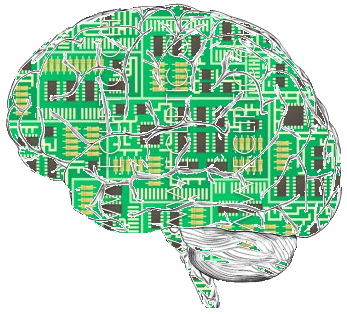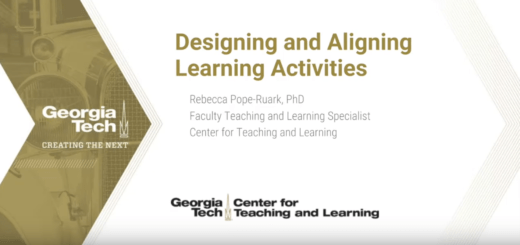Learning Myth Busters: Multitasking

You’re busy. I’m busy. Our students are busy. There’s something about modern American life the keeps us running in 5th gear, trying to cram more productivity into our limited waking hours. Being “busy” has become a status symbol. Immersed in a culture this addicted to multitasking, our students are falling for a common myth: that the human brain can actually do multiple things at once.
Man vs machine
Perhaps you have heard the common analogy that the human brain works like a computer. We put information in, we store it for some amount of time, we retrieve it. While you are reading this blog post, your computer is running a number of processes in the background that you don’t even notice. This is true for your brain, too. While you are reading this blog post, your brainstem is keeping your heart beating and your lungs inflating, your cerebellum is maintaining your balance to keep you from falling out of your chair, your occipital lobe is processing these words and your temporal lobe is likely tuning out the ambient sounds around you. In this way, both your computer and your brain are able to multitask, because the tasks are carried out in different functional areas.
What happens if you decide to stop reading this blog post and use the same device to search something on the web, compose a Word document, or manipulate figures in Excel? You must switch applications. The same thing happens with conscious cognitive processing in your brain. You cannot simultaneously study Kant and watch YouTube videos.
But wait, don’t we all multitask? We answer emails while sitting in faculty meetings. We talk with our family while thinking about work. And our students? They respond to texts while studying. Surf the web in class. Although we can switch our attention from task to task so quickly that it can feel like we are actually doing two things at once, we are actually doing what psychologists call “task switching”. Rapidly switching our attention between tasks creates the illusion of doing two things at once.
What does task switching mean for performance?
Why is it so dangerous to text and drive? The danger is only partially due to the physical behavior of taking your eyes off the road and your hand off the wheel. More importantly, your brain is distracted from the business of driving in order to concentrate on the text. You are not simultaneously texting and driving: you are driving for a moment and not texting and then texting for a moment and NOT driving. If you think about it this way, on average, you are only HALF driving! As you might expect, this has disastrous consequences for the quality of our driving.
Attention is a limited resource. Attending to a single task requires cognitive effort. Switching between tasks requires even more cognitive effort, which overtaxes our available pool of resources and decreases performance.
What does task switching mean for learning?
For as long as there have been lectures, there have been distracted students in attendance. Today, our ubiquitous devices provide an endless array of distractions. Even if students have the best intentions of maintaining their attention on the lecture, those with laptops or phones experience strong temptations to divert their attention to other work or personal communication. In a study by Ravizza, Uitvlugt, and Fenn (2016), students voluntarily logged in to a proxy server at the beginning of class to allow researchers to track their internet use. Students in this study spent about a third of class time (40 minutes out of 100 minute class) using the internet for non-academic purposes, including email, reading the news, chatting, shopping, watching videos, and engaging with social media. These same students spent less than 5 minutes using the internet for academic purposes, such as accessing the syllabus, reviewing course material, and searching the internet for content related to the lecture. Academic use of the internet was unrelated to final exam scores (not surprising, given the small amount of time dedicated to such activity), while non-academic internet use was negatively associated with final exam scores – even when the influence of interest, motivation, and intelligence were controlled.
Recent studies have investigated the impact of laptops in the classroom on not only the user, but also their neighbors. According to Sana, Weston, and Cepeda (2013), students distracted by laptop use scored 11% lower on a post-lecture comprehension test. Perhaps surprisingly, a 17% decrease in performance was observed for the neighboring students who could see this distracted student’s laptop. Not only does task switching decrease performance for the distracted student, but this behavior spills over to decrease performance in others.
What to do?
While many faculty have been frustrated to look out into the classroom only to see a sea of glassy eyes trained on computer screens or hidden-under-the-desk cell phones, we have also found many useful ways to use technology to support learning through polls, exercises, simulations, research, and more. The question shouldn’t be whether to allow technology in the classroom, as debated recently on Twitter and reported in the Chronicle, but rather how best to harness its benefits for learning.
Just as our devices came with users manuals, sometimes our students need a primer on how to be productive. Let’s break the myth of multitasking, starting with our own work. We should start by minimizing our own obsession with multitasking. Next, let’s help students manage their attention in the classroom by addressing the dangers of task switching. If we can convince them that multitasking is a myth, we may find better attention leads to better learning.
References
Bellezza, S., Paharia, N, & Keinan, A. (2016). Conspicuous consumption of time: When busyness and lack of leisure time become a status symbol. Journal of Consumer Research, 44(1), 118-138.
Mueller, P.A. & Oppenheimer, D.M. (2014). The pen is mightier than the keyboard: Advantages of longhand over laptop note taking. Psychological Science. DOI: 10.1177/0956797614524581.
Ravizza, S.M., Uitvlugt, M.G., & Fenn, K.M. (2016). Logged in and zoned out: How laptop internet use relates to classroom learning. Psychological Science. DOI: 10.1177/0956797616677314.
Sana, F., Weston, T., Cepeda, N. (2013). Laptop multitasking hinders classroom learning for both users and nearby peers. Computers & Education, 62, 24-31. DOI: 10.1016/j.compedu.2012.10.003.




